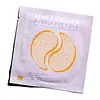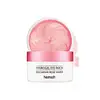What's inside
What's inside
 Key Ingredients
Key Ingredients

 Benefits
Benefits

 Concerns
Concerns

 Ingredients Side-by-side
Ingredients Side-by-side

Water
Skin ConditioningGlycerin
HumectantDipropylene Glycol
HumectantCeratonia Siliqua Gum
EmollientChondrus Crispus Powder
AbrasiveButylene Glycol
HumectantPaeonia Suffruticosa Root Extract
Skin ProtectingFragaria Chiloensis Fruit Extract
Skin ConditioningHydrolyzed Gardenia Florida Extract
AntioxidantCentella Asiatica Extract
CleansingChondrus Crispus Extract
Skin ConditioningChamomilla Recutita Flower Extract
MaskingResveratrol
Antioxidant1,2-Hexanediol
Skin ConditioningHyaluronic Acid
HumectantCellulose Gum
Emulsion StabilisingAllantoin
Skin ConditioningAlgin
MaskingXanthan Gum
EmulsifyingGlyceryl Caprylate
EmollientBetaine
HumectantPotassium Chloride
Polysorbate 20
EmulsifyingSucrose
HumectantEthylhexylglycerin
Skin ConditioningDextrin
AbsorbentMaltodextrin
AbsorbentDisodium EDTA
Limonene
PerfumingParfum
MaskingWater, Glycerin, Dipropylene Glycol, Ceratonia Siliqua Gum, Chondrus Crispus Powder, Butylene Glycol, Paeonia Suffruticosa Root Extract, Fragaria Chiloensis Fruit Extract, Hydrolyzed Gardenia Florida Extract, Centella Asiatica Extract, Chondrus Crispus Extract, Chamomilla Recutita Flower Extract, Resveratrol, 1,2-Hexanediol, Hyaluronic Acid, Cellulose Gum, Allantoin, Algin, Xanthan Gum, Glyceryl Caprylate, Betaine, Potassium Chloride, Polysorbate 20, Sucrose, Ethylhexylglycerin, Dextrin, Maltodextrin, Disodium EDTA, Limonene, Parfum
Water
Skin ConditioningGlycerin
HumectantNiacinamide
SmoothingChondrus Crispus
MaskingButylene Glycol
HumectantCocos Nucifera Fruit Extract
EmollientPinus Sylvestris Leaf Extract
TonicPropanediol
SolventPentylene Glycol
Skin ConditioningRosa Damascena Flower Water
MaskingNelumbo Nucifera Flower Extract
Skin ConditioningPortulaca Oleracea Extract
Skin ConditioningHamamelis Virginiana Extract
AntiseborrhoeicCentella Asiatica Extract
CleansingEthylhexylglycerin
Skin ConditioningSodium Hyaluronate
HumectantDipotassium Glycyrrhizate
HumectantPEG-60 Hydrogenated Castor Oil
EmulsifyingCeratonia Siliqua Gum
EmollientSucrose
HumectantPotassium Chloride
Cyamopsis Tetragonoloba Gum
Emulsion StabilisingCalcium Chloride
AstringentAllantoin
Skin ConditioningTripropylene Glycol
AntioxidantDipropylene Glycol
HumectantCellulose Gum
Emulsion StabilisingChondrus Crispus Powder
AbrasiveRicinus Communis Seed Oil
MaskingCalcium Aluminum Borosilicate
Tin Oxide
AbrasiveCI 75470
Cosmetic ColorantCalcium Lactate
AstringentAdenosine
Skin ConditioningSynthetic Fluorphlogopite
Titanium Dioxide
Cosmetic ColorantDisodium EDTA
Ethyl Hexanediol
Solvent1,2-Hexanediol
Skin ConditioningChlorphenesin
AntimicrobialArginine
MaskingParfum
MaskingWater, Glycerin, Niacinamide, Chondrus Crispus, Butylene Glycol, Cocos Nucifera Fruit Extract, Pinus Sylvestris Leaf Extract, Propanediol, Pentylene Glycol, Rosa Damascena Flower Water, Nelumbo Nucifera Flower Extract, Portulaca Oleracea Extract, Hamamelis Virginiana Extract, Centella Asiatica Extract, Ethylhexylglycerin, Sodium Hyaluronate, Dipotassium Glycyrrhizate, PEG-60 Hydrogenated Castor Oil, Ceratonia Siliqua Gum, Sucrose, Potassium Chloride, Cyamopsis Tetragonoloba Gum, Calcium Chloride, Allantoin, Tripropylene Glycol, Dipropylene Glycol, Cellulose Gum, Chondrus Crispus Powder, Ricinus Communis Seed Oil, Calcium Aluminum Borosilicate, Tin Oxide, CI 75470, Calcium Lactate, Adenosine, Synthetic Fluorphlogopite, Titanium Dioxide, Disodium EDTA, Ethyl Hexanediol, 1,2-Hexanediol, Chlorphenesin, Arginine, Parfum
 Reviews
Reviews

Ingredients Explained
These ingredients are found in both products.
Ingredients higher up in an ingredient list are typically present in a larger amount.
1,2-Hexanediol is a synthetic liquid and another multi-functional powerhouse.
It is a:
- Humectant, drawing moisture into the skin
- Emollient, helping to soften skin
- Solvent, dispersing and stabilizing formulas
- Preservative booster, enhancing the antimicrobial activity of other preservatives
Allantoin is a soothing ingredient known for its protective and moisturizingg properties. Because of this, it is often added to products with strong active ingredients.
Studies show higher concentrations of this ingredient can promote wound healing.
Though it can be derived from the comfrey plant, allantoin is produced synthetically for cosmetic products to ensure purity.
Learn more about AllantoinButylene Glycol (or BG) is used within cosmetic products for a few different reasons:
Overall, Butylene Glycol is a safe and well-rounded ingredient that works well with other ingredients.
Though this ingredient works well with most skin types, some people with sensitive skin may experience a reaction such as allergic rashes, closed comedones, or itchiness.
Learn more about Butylene GlycolCellulose Gum is a water-soluble polymer that comes from cellulose. It is used to change the texture of a product and to help stabilize emulsions.
As an emulsifier, cellulose gum specifically thicken the texture of water-based products.
This ingredient is considered hypoallergenic and non-toxic. Cellulose Gum can be found in cosmetics, food, and other household goods such as paper products.
Learn more about Cellulose GumCentella Asiatica Extract (Centella) is derived from an herb native to Southeast Asia. It is famous for its anti-inflammatory and soothing properties.
Centella is rich in antioxidants and amino acids, such as Madecassic Acid and Asiaticoside.
Studies show the compounds in centella help with:
The combination of all these properties makes centella effective at soothing, hydrating, and protecting the skin.
Other great components of centella include Vitamin A, vitamin C, several B vitamins, and Asiatic Acid.
Fun fact: Centella has been used as a medicine and in food for many centuries. As a medicine, it is used to treat burns, scratches, and wounds.
Learn more about Centella Asiatica ExtractCeratonia Siliqua Gum is extracted from the seeds of the carob tree. You might know this ingredient as Carob Gum or Locust Bean Gum. It is used to stabilize other ingredients and improve the texture of products.
Carob gum is made up of long-chain polysaccharides. This makes it a natural thickener.
Yes! This ingredient comes from the seeds of a tree. The name 'Locust Bean Gum' can be misleading.
Learn more about Ceratonia Siliqua GumChondrus Crispus Powder is an exfoliant.
Dipropylene Glycol is a synthetically created humectant, stabilizer, and solvent.
This ingredient helps:
Dipropylene glycol is technically an alcohol, but it belongs to the glycol family (often considered part of the ‘good’ alcohols). This means it is hydrating and gentle on skin unlike drying solvent alcohols like denatured alcohol.
As a masking agent, Dipropylene Glycol can be used to cover the smell of other ingredients. However, it does not have a scent.
Studies show Dipropylene Glycol is considered safe to use in skincare.
Learn more about Dipropylene GlycolDisodium EDTA plays a role in making products more stable by aiding other preservatives.
It is a chelating agent, meaning it neutralizes metal ions that may be found in a product.
Disodium EDTA is a salt of edetic acid and is found to be safe in cosmetic ingredients.
Learn more about Disodium EDTAEthylhexylglycerin (we can't pronounce this either) is commonly used as a preservative and skin softener. It is derived from glyceryl.
You might see Ethylhexylglycerin often paired with other preservatives such as phenoxyethanol. Ethylhexylglycerin has been found to increase the effectiveness of these other preservatives.
Glycerin is already naturally found in your skin. It helps moisturize and protect your skin.
A study from 2016 found glycerin to be more effective as a humectant than AHAs and hyaluronic acid.
As a humectant, it helps the skin stay hydrated by pulling moisture to your skin. The low molecular weight of glycerin allows it to pull moisture into the deeper layers of your skin.
Hydrated skin improves your skin barrier; Your skin barrier helps protect against irritants and bacteria.
Glycerin has also been found to have antimicrobial and antiviral properties. Due to these properties, glycerin is often used in wound and burn treatments.
In cosmetics, glycerin is usually derived from plants such as soybean or palm. However, it can also be sourced from animals, such as tallow or animal fat.
This ingredient is organic, colorless, odorless, and non-toxic.
Glycerin is the name for this ingredient in American English. British English uses Glycerol/Glycerine.
Learn more about GlycerinParfum is a catch-all term for an ingredient or more that is used to give a scent to products.
Also called "fragrance", this ingredient can be a blend of hundreds of chemicals or plant oils. This means every product with "fragrance" or "parfum" in the ingredients list is a different mixture.
For instance, Habanolide is a proprietary trade name for a specific aroma chemical. When used as a fragrance ingredient in cosmetics, most aroma chemicals fall under the broad labeling category of “FRAGRANCE” or “PARFUM” according to EU and US regulations.
The term 'parfum' or 'fragrance' is not regulated in many countries. In many cases, it is up to the brand to define this term.
For instance, many brands choose to label themselves as "fragrance-free" because they are not using synthetic fragrances. However, their products may still contain ingredients such as essential oils that are considered a fragrance by INCI standards.
One example is Calendula flower extract. Calendula is an essential oil that still imparts a scent or 'fragrance'.
Depending on the blend, the ingredients in the mixture can cause allergies and sensitivities on the skin. Some ingredients that are known EU allergens include linalool and citronellol.
Parfum can also be used to mask or cover an unpleasant scent.
The bottom line is: not all fragrances/parfum/ingredients are created equally. If you are worried about fragrances, we recommend taking a closer look at an ingredient. And of course, we always recommend speaking with a professional.
Learn more about ParfumPotassium Chloride can be bad for oily skin and be bad for acne prone skin.
Sucrose is a natural sugar found in fruits, vegetables, and nuts. It is the main constituent of white sugar.
In skincare, sucrose is a humectant and can be a mild exfoliant.
Sucrose is hydrophilic, meaning it attracts water. This makes it an effective humectant and helps hydrate the skin.
Studies show sugars may worsen acne-prone skin due to it disrupting the skin's natural biome. We recommend speaking with a professional if you have any concerns.
In some products such as body scrubs, sucrose is used as an gentle exfoliant.
The term 'sucrose' comes from the french word for sugar, 'sucre'.
Learn more about SucroseWater. It's the most common cosmetic ingredient of all. You'll usually see it at the top of ingredient lists, meaning that it makes up the largest part of the product.
So why is it so popular? Water most often acts as a solvent - this means that it helps dissolve other ingredients into the formulation.
You'll also recognize water as that liquid we all need to stay alive. If you see this, drink a glass of water. Stay hydrated!
Learn more about Water